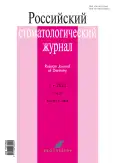Quality of life of patients without teeth, which are prosthetized
- Authors: Terechov M.S.1, Apresyan S.V.1, Stepanov A.G.1, Kiryushin M.A.1
-
Affiliations:
- RUDN University
- Issue: Vol 27, No 1 (2023)
- Pages: 51-62
- Section: Clinical Investigation
- URL: https://journals.rcsi.science/1728-2802/article/view/133031
- DOI: https://doi.org/10.17816/dent181636
- ID: 133031
Cite item
Abstract
BACKGROUND: High-quality rehabilitation of patients without teeth is one of the urgent problems in dentistry today. Owing to the growing number of older patients and the need for quality treatment, the most physiologically accurate complete removable dentures that meet the needs of patients and reduce negative effects after treatment must be manufactured.
AIM: To determine and compare the effect of complete removable dentures, made by computer-aided design and computer-aided manufacturing methods, on the quality of life of patients without teeth.
MATERIALS AND METHODS: The clinical study involved 60 older patients (aged >60 years) without upper and lower teeth. These patients were randomly divided into two equal groups. In the first group, removable dentures were manufactured using digital technologies. In the second group, removable dentures were made by traditional technology. The quality of life of all patients before and after treatment was evaluated using the OHIP-14 questionnaire.
RESULTS: More positive assessments were noted in the change in the state after prosthetics with full removable dentures made by digital technology. With approximately total equal indicators of the questionnaire, the best values of the clinical effect were found in the digital technology for making prostheses with 3.74 versus 1.19. When comparing individual categories, eating problems, communication problems, everyday living problems, and clinical performance were markedly higher with digital manufacturing technology.
CONCLUSION: The clinical efficacy of treatment with prostheses made using digital technology is on average approximately 3.14 times higher (p <0.001) than that in orthopedic rehabilitation using prostheses made by analog traditional technology. Thus, better clinical results are obtained in patients using prostheses made by the proposed technology for making complete removable dentures.
Full Text
##article.viewOnOriginalSite##About the authors
Matvey S. Terechov
RUDN University
Email: matter25@mail.ru
ORCID iD: 0000-0003-3498-0855
SPIN-code: 7472-9031
postgraduate student
Russian Federation, 6 Miklukho-Maklaya street, 117198 MoscowSamvel V. Apresyan
RUDN University
Email: dr.apresyan@gmail.com
ORCID iD: 0000-0002-3281-707X
Scopus Author ID: 741742
MD, Dr. Sci. (Med.), Professor, dentist
Russian Federation, 6 Miklukho-Maklaya street, 117198 MoscowAlexander G. Stepanov
RUDN University
Email: stepanovmd@list.ru
ORCID iD: 0000-0002-6543-0998
Scopus Author ID: 737926
MD, Dr. Sci. (Med.), Professor
Russian Federation, 6 Miklukho-Maklaya street, 117198 MoscowMaxim A. Kiryushin
RUDN University
Author for correspondence.
Email: Kirushinma@mail.ru
ORCID iD: 0000-0002-2834-5874
SPIN-code: 3620-7094
MD, Cand. Sci. (Med.), Assistant Professor
Russian Federation, 6 Miklukho-Maklaya street, 117198 MoscowReferences
- World report on aging and health. World Health Organization, Switzerland: Geneva, 2021.
- Zagorsky VA. Protezirovanie pri polnoi adentii: manual for physicians. Moscow: Medicine, 2008. 376 p. (In Russ).
- Musheev IU, Olesova VN, Framovich OZ. Prakticheskaya dental’naya implantologiya. Moscow: Lokus Standi, 2008. 497 p. (In Russ).
- Apresyan SV. Digital planning of orthopedic dental treatment. Russian Journal of Dentistry. 2019;23(3–4):158–164. (In Russ). doi: 10.18821/1728-2802-2019-23-3-4-158-164
- Apresyan SV, Stepanov AG, Antonik MM, et al. Kompleksnoe tsifrovoe planirovanie stomatologicheskogo lecheniya, prakticheskoe rukovodstvo. Ed by Apresyan S.V. Moscow: Mozartika, 2020. (In Russ).
- Han W, Li Y, Zhang Y, et al. Design and fabrication of complete dentures using CAD / CAM technology. Medicine. 2017;96(1):e5435. doi: 10.1097/md.0000000000005435
- Steinmassl P-A, Klaunzer F, Steinmassl O, et al. Evaluation of Currently Available CAD/CAM Denture Systems. The International Journal of Prosthodontics. 2017;30(2):116–122. doi: 10.11607/ijp.5031
- Srinivasan M, Gjengedal M, Cattani-Lorente M, et al. CAD / CAM milled complete removable dental prostheses: An in vitro evaluation of biocompatibility, mechanical properties, and surface roughness. Dental Materials Journal. 2018;37(4):526–533. doi: 10.4012/dmj.2017-207
- Kalberer N, Mehl A, Schimmel M, et al. CAD-CAM milled versus rapidly prototyped (3D-printed) complete dentures: An in vitro evaluation of trueness. The Journal of Prosthetic Dentistry. 2019;121(4):637-643. doi: 10.1016/j.prosdent.2018.09.001
- Jung S, Park C, Yang H-S, et al. Comparison of different impression techniques for edentulous jaws using three-dimensional analysis. The Journal of Advanced Prosthodontics. 2019;11(3):179. doi: 10.4047/jap.2019.11.3.179
- Apresyan SV, Terekhov MS. Comparative analysis of modern methods of manufacturing complete removable dentures. Clinical dentistry. 2020;1(93):76–79. (In Russ). doi: 10.37988/1811-153X_2020_1_76
- Semenova VA, Terekhov MS, Apresyan SV, Stepanov AG. Clinical justification of the use of digital technologies in prosthetics of patients with complete absence of tee. Clinical dentistry. 2022;25(1):98–106. doi: 10.37988/1811-153X_2022_1_98
- Radford DR, Juszczyk AS, Clark RK. The bond between acrylic resin denture teeth and the denture base: recommendations for best practice. Br Dent J. 2014;216:165–167. doi: 10.1038/sj.bdj.2014.99
- Meneghihi A, Mazzarella S, Di Franco A. Full upper and lower duplicate dentures using Vertysystem Furbo. GAP Australasian-Dentist. 2019:82–84.
- Patent RUS 2722458. MPK A61C13/00. 2020107773. Application 20.02.2020. Published 01.06.2020. Byul. № 16. (In Russ).
- Apresyan SV, Kravets PL, Stepanov AG, Terekhov MS. Sposob izgotovleniya s”emnykh zubnykh protezov. Patent RUS 2721891. MPK A61C9/00. 2020107774. Application 20.02.2020. Published 25.05.2020. Byul. № 15. (In Russ).
- Terekhov MS, Semenova VA, Apresyan SV, et al. Development of a digital fabrication device for the manufacture of removable dentures. Russian Journal of Dentistry. 2021;25(4):315–322. (In Russ). doi: 10.17816/1728-2802-2021-25-4-315-322
- Apresyan SV, Terekhov MS, Stepanov AG, et al. Innovative technologies for the manufacture of complete removable dentures. Clinical dentistry. 2020;4(96):75–79. doi: 10.37988/1811-153X_2020_4_75.
Supplementary files

















